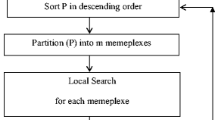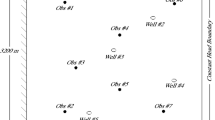Abstract
A nonlinear programming (NLP) optimization model has been developed for the minimum cost design of infiltration basins and infiltration trenches. The focus of this optimization model and approach is to provide a functional and versatile tool to simultaneously determine the peak inflow and runoff from a design storm event based on watershed parameters, and to optimize the size of an infiltration basin based on the design storm parameters, infiltration characteristics, basin capacity, and mounding. Two optimization models are developed, one is based upon the rational method and the second is based upon the modified rational method. Both approaches use the Green-Ampt method for infiltration, in addition to a method for defining the mounding effects. The various hydrologic concepts are defined through constraints in the optimization models. No previous optimizations models for infiltration basin design have been developed that can accomplish the detail of this new model. The nonlinear programming model is solved using the GAMS (General Algebraic Modeling system) software which is readily available.



Similar content being viewed by others
References
Akan AO (1993) Urban stormwater hydrology. Technomic Publishing Company, Inc., Lancaster
Akan AO (2002) Sizing stormwater infiltration structures. J Hydraul Eng 128(5):534–537
Behera PK, Papa F, Adams BJ (1999) Optimization of regional storm-water management systems. J Water Resour Plan Manag 125(2):107–114
Bennett MS, Mays LW (1985) Optimal design of detention and drain channel systems. J Water Resour Plan Manag 111(12):99–112
Bouwer H, Back JT, Oliver JM (1999) Predicting infiltration and ground-water mounds for artificial recharge. J Hydrol Eng 4(4):350–357
Brummer J (1995) A constructive solution for optimal local control of runoff events. Math Comput Simul 39(1):39–52
California Dept. of Transportation (2000) Stormwater quality handbook, Project planning and design guide
Carleton GB (2010) Simulation of groundwater mounding beneath hypothetical stormwater infiltration basins, Scientific Investigations Report 2010–5102. U.S. Geological Survey, Reston, Virginia, Prepared in cooperation with the New Jersey Department of Environmental Protection
Chill J, Mays LW (2013) Determination of optimal location for developments to minimize detention requirements. Water Resour Manag 27(15):5089–5100
Chow VT, Maidment DR, Mays LW (1988) Applied hydrology. McGraw-Hill, New York
Emerson C, Welty C, Traver R (2005) Watershed-scale evaluation of a system of storm water detention basins. J Hydrol Eng 10(3):237–242
Federal Highway Administration (1996) Urban drainage design manual, Hydrologic Engineering Circular No. 22, Washington, DC
Gams Algebraic Modeling System (GAMS) (2014) www.gams.com
Goff KM, Gentry RW (2006) The influence of watershed and development characteristics on the cumulative impacts of stormwater detention ponds. Water Resour Manag 20(6):829–860
Green WH, Ampt GA (1911) Studies on soil physics. I. The flow of air and water through soil. J Agric Sci 9:1–24
Griffin DM Jr, Warrington RO (1988) Examination of 2-D ground-water recharge solution. J Irrig Drain Eng 114(4):691–704
Guo JCY (1998) Surface-subsurface model for trench infiltration basins. J Water Resour Plan Manag 124(5):280–284
Guo JCY (1999) Detention storage volume for small urban catchments. J Water Resour Plan Manag 125(6):380–382
Guo JCY (2001a) Design of circular infiltration basin under water mounding effects. J Water Resour Plan Manag 127(1):58–65
Guo JCY (2001b) Hydrologic design of urban flood control detention ponds. J Hydrol Eng 6(6):472–479
Guo JCY (2001c) Design of infiltration basins for stormwater. In: Mays LW (ed) Chapter 8 Stormwater collection systems design handbook. McGraw-Hill, New York
Guo JCY (2002) Overflow risk of storm water BMP basin design. J Hydrol Eng 7(6):428–434
Guo JCY (2003) Design of infiltrating basin by soil storage and conveyance capacities. Int J Water 28(4):411–415
Guo JCY, Hughes W (2001) Storage volume and overflow risk for infiltration basin design. J Irrig Drain Eng 127(3):170–175
Guo JCY, Urbonas B (2002) Runoff capture and delivery curves for storm water-quality control designs. J Water Resour Plan Manag 128(3):208–215
Hantush MS (1967) Growth and decay of groundwater mounds in response to uniform percolation. Water Resour Res 3:227–234
Heitz LF, Khosrowpanah S, Nelson J (2000) Sizing of surface water runoff detention ponds for water quality improvement. J Am Water Resour Assoc 36(3):541–548
Marino MA (1975a) Artificial groundwater recharge I. Circular recharging area. J Hydrol 25:201–208
Marino MA (1975b) Artificial ground water recharge II. Rectangular recharging area. J Hydrol 26:29–37
Maryland Department of Natural Resources (1984) Standards and specifications for infiltration practices. Water Resources Administration, Storm Water Management Division, Annapolis, MD
Mays LW (2001) Stormwater collection systems design handbook. LW Mays, Editor-in-Chief. McGraw-Hill, New York
Mays LW (2011) Water resources engineering, 2nd edn. Wiley, Hoboken
Mays LW (2012) Ground and surface water hydrology. Wiley, Hoboken
Mays LW, Bedient PB (1982) Model for optimal size and location of detention. J Water Resour Plan Manag 108(3):270–285
Mays LW, Tung YK (1992) Hydrosystems engineering and management. McGraw-Hill, New York
Molden DJ, Sunada DK, Warner JW (1984) Microcomputer model of artificial recharge using Glover’s solution. Ground Water 22(1):73–79
Morel-Seytoux HJ, Miracapillo C, Abdulrazzak MJ (1990) A reductionist physical approach to unsaturated aquifer recharge from a circular spreading basin. Water Resour Res 26:771–777
New Jersey Department of Environmental Protection (NJDEP) (2004) New Jersey Stormwater Best Management Practices Manual, Chapter 9.5, Standard for Infiltration Basins
Ortiz NV, Zachmann DQ, McWhorter DB, Sunada DK (1979) Effects of in-transit water on groundwater mounds beneath circular and rectangular recharge areas. Water Resour Res 15(3):577–582
Oxley RL, Mays LW (2014) Optimization - simulation model for detention basin system design. Water Resour Manag 28(4):1157–1171
Papa F, Adams BJ (1997) Application of derived probability and dynamic programming techniques to planning regional stormwater management systems. Water Sci Technol 36(5):227–234
Parker D, Schaefer K, Champagne PC (2002) Design of stormwater management facilities. In: Dewberry SO (ed) Land development handbook. McGraw-Hill, New York, pp 475–533
Perez-Pedini C, Limbrunner JF, Vogel RM (2005) Optimal location of infiltration-based best management practices for storm water management. J Water Resour Plan Manag 131(6):441–448
Rawls WJ, Brakensiek DL, Miller N (1983) Green-Ampt infiltration parameters from soils data. J Hydraul Div ASCE 109(1):62–70
Schueler TR (1987) Controlling urban runoff: A practical manual for planning and designing urban BMPs. Metropolitan Washington Council of Governments, Washington
Schueler TR, Kumble PA, Heraty M (1992) A current assessment of urban best management practices. Metropolitan Washington Council of Governments. Washington, DC
Sumner DM, Rolston DE, Marino MA (1999) Effects of unsaturated zone on groundwater mounding. J Hydrol Eng 4(1):65–69
Swamee PK, Ojha CSP (1997) Ground-water mound equation for rectangular recharge area. J Irrig Drain Eng 123(3):215–217
Taur CK, Toth G, Oswald GE, Mays LW (1987) Austin detention basin optimization model. J Hydraul Eng 113(7):860–878
Travis QB, Mays LW (2008) Optimizing retention basin networks. J Water Resour Plan Manag 134(5):432–439
Williams ES, Wise WR (2006) Hydrologic impacts of alternative approaches to storm water management and land development. J Am Water Resour Assoc 42(2):443–455
Yeh CH, Labadie JW (1997) Multi-objective watershed-level planning of storm water detention systems. J Water Resour Plan Manag 123(6):336–343
Yen BC, Akan AO (1999) Hydraulic design of urban drainage systems. In: Mays LW (ed) Hydraulic Design Handbook. McGraw-Hill, New York
Zhen XY, Yu SL, Lin JY (2004) Optimal location and sizing of stormwater basins at watershed scale. J Water Resour Plan Manag 130(4):339–347
Conflict of Interest
There is no conflict of interest.
Author information
Authors and Affiliations
Corresponding author
Rights and permissions
About this article
Cite this article
Stafford, N., Che, D. & Mays, L.W. Optimization Model for the Design of Infiltration Basins. Water Resour Manage 29, 2789–2804 (2015). https://doi.org/10.1007/s11269-015-0970-6
Received:
Accepted:
Published:
Issue Date:
DOI: https://doi.org/10.1007/s11269-015-0970-6




